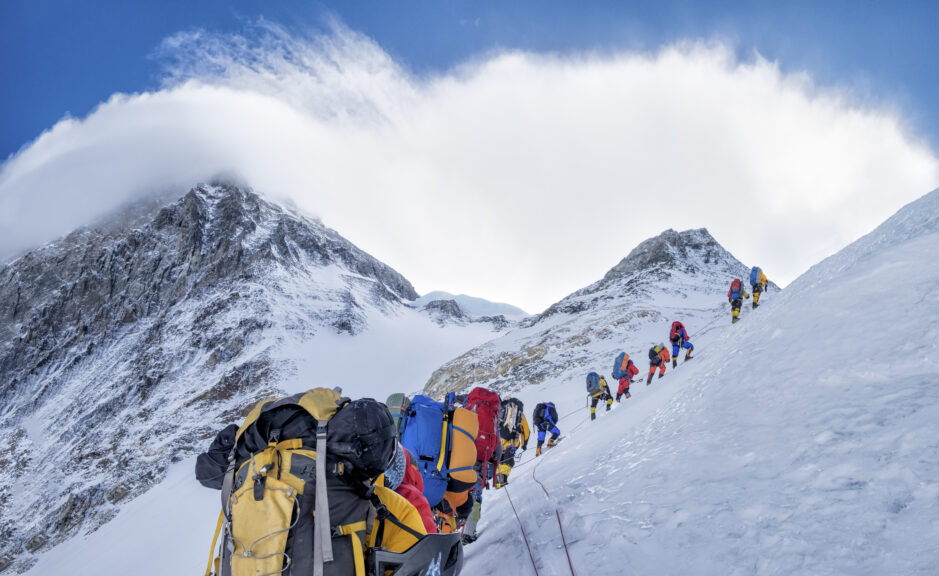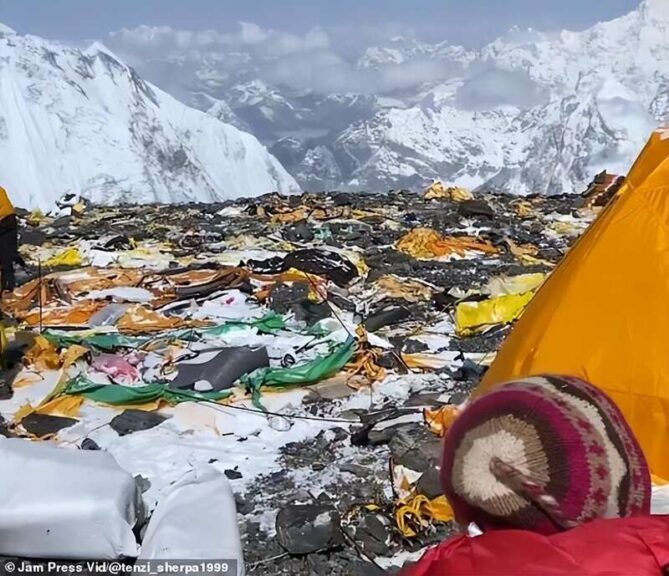For most people, hearing the name “Mount Everest” brings to mind images of a pristine snow capped peak, perhaps with a brave climber standing atop it with an arm raised in triumph. After all, this person must have reached the pinnacle of human achievement by ascending the world’s highest mountain.
Does it get any better than that?
This idyllic view of Everest is slowly being erased, however, as stories about the mountain’s harsh realities make the rounds on social media. It’s already widely understood that not everyone who tries to make it to the top of the world makes it back down. But that’s only the beginning of the drama.
Located between Nepal and Tibet, Mount Everest is the world’s tallest peak. This majestic mountain sits at 29,029 feet above sea level. Oxygen is so thin at the top that it’s called the “death zone.” This is where even the most experienced climbers succumb to their bodies breaking down and for some, that means extreme sickness or even death.
Since the 1900s, more than 300 people have died trying to scale the icy terrain of Everest. Per an Insider report, 2023 is shaping up to be a particularly deadly year, with 12 climbers pronounced dead already and 5 still missing. Two factors contributing to these high rates of fatality are altitude sickness and overcrowding on the mountain.

Westend61. Getty Images.
Despite its risks, climbing Mount Everest has become more popular than ever — blame it on social media, boredom, or just people inherently wanting to one-up each other. No matter the reason, the increased interest in scaling the world’s highest peak is now so extreme that new guidelines were instituted for this year.
These rules include stipulations prohibiting solo climbers (everyone must have a trained sherpa). All climbers must have successfully climbed a peak at least 7,000 feet high previously. People over 75, double amputees, and blind persons are all prohibited from climbing.
It’s all part of an effort to stop overcrowding. Filmmaker and director Jennifer Peedom told Insider, “It is extremely overcrowded now and just getting more and more every year.”
The publication noted that Nepal issued a record 463 permits to people who want to climb Mount Everest during the 2023 season, meaning about 900 people will jostle to reach the summit this year alone. Things get dicey in May when wind dies down and temperatures warm. This is when there’s a literal line up the mountain, with climbers pushing their way to the top.
Many people are aware of the fact that Everest is littered with dead bodies because it’s too costly and dangerous to remove them. But what fewer observers realize is that the mountain is also littered with … trash. And there’s a lot of it.
A video of the garbage-strewn base camp went viral on Instagram in mid-May, just ahead of the 70th anniversary of Edmund Hillary and Tenzing Norgay’s ascending Everest for the first time on May 29, 1953. The duo is believed to be the first to reach the mountain’s peak.

Jam Press Vid/@tenzi_sherpa1999
The post came from mountain guide Tenzi Sherpa, who has been guiding climbers to the summit since 2019. “The dirtiest camp I have ever seen,” he wrote in the caption.
“I think the government should make strict rules for those who leave trash [on Mount Everest], and a more effective cleaning campaign project should be held,” the guide told Newsweek about his video post.
As concerning as the trash piles are among the white snow, the sherpa’s video isn’t even the strangest story to come from Everest this season. That title belongs to the tale of a guide who allegedly saved a dying climber’s life only to have the man supposedly block him later on social media.
The story goes that Malaysian climber Ravichandran, who goes by the name Ravichandran Everest or Ravi, was attempting to scale Everest when he succumbed to altitude sickness and collapsed not far from the summit. Video footage shows Gelje Sherpa, who had been climbing with a different client when he came upon the body, wrapping a mattress around the man and strapping the climber onto his back. He abandoned his own client’s summit push to hike the man down to safety.
Footage of the incident was shared by Twitter user Visakan Veerasamy. The video went viral and has been watched more than 1.3 million times.
there's an incredible story going on in the mountaineering community rn. there's a Malaysian climber who was at death's door, and was rescued by a sherpa who risked his own life to carry his lifeless body on his back for 6 hours. The climber then blocked the sherpa on Instagram https://t.co/AJW70vJ3Kr
— Visakan Veerasamy (@visakanv) June 4, 2023
Gelje shared on Instagram on May 20: “You may all be wondering where is the summit photo? Unfortunately no summit yet. At the Balcony during our summit push around 8,300m I saw someone in danger.”
“A man who needed rescuing and no one else was helping. I made the decision to cancel our clients summit push so that I could bring him down to safety before he died up there alone. I carried him myself all the way down to Camp 4 where a rescue team helped from then on. I will be back up the mountain soon after regaining energy from a huge task but I am so happy to say he is alive and recovering in hospital.”
But just after this incredible story came to light, Ravi allegedly blocked Gelje on social media and refused to acknowledge his assistance. He posted about the incident several days later after getting a lot of negative attention on social media.
“Sherpas are people who are so committed and dedicated to their clients especially coming from ’14 Peaks Expedition Co. & The Seven Summit Expedition Co. They never leave you behind. I experienced it this year. When descending from [the] summit, I had difficulty. Tashi heard that I [was] in trouble, he organised the rescue team (Mingma Tendi, Gelje Sherpa, Nima Dorchi, Nima Tashi, Dawa Sherpa and Dipen Bhote). They are high altitude sherpas who make lots of sacrifices for their clients. They brought me to 7300 meter[s] for Heli Pick-up for a quick Heli flight to Hospital. Sherpas are important in my 8000 meter expeditions,” he wrote.
Gelje Sherpa responded by saying in the comments, “Thank you [clasped hands emoji] hope you are recovering well.”
Daring rescues aside, there’s no denying that climbing Mount Everest has changed a lot in the past seven decades since it began. Anyone seeking to reach the top of the world today should first know what they’re in for.
“There’s sort of this idea that there’s only one mountain that really matters in the kind of Western, popular imagination,” Peedom told Business Insider. She’s climbed the mountain four times, but said the modern experience is nothing compared to what it used to be.
“There seems to be a disaster mystique around Everest that seems to only serve to heighten the allure of the place,” she told the publication. “It is extremely overcrowded now and just getting more and more every year.”

Continue reading this exclusive article and join the conversation, plus watch free videos on DW+
Already a member?

.png)
.png)

